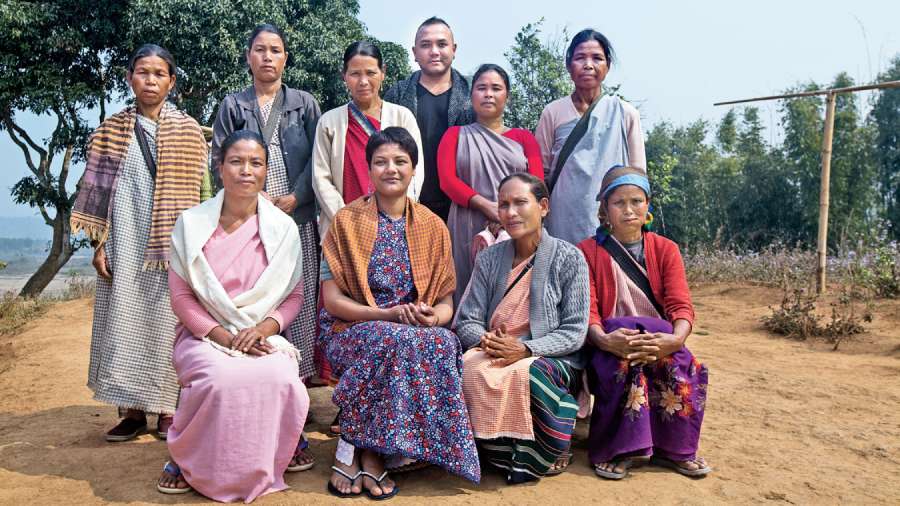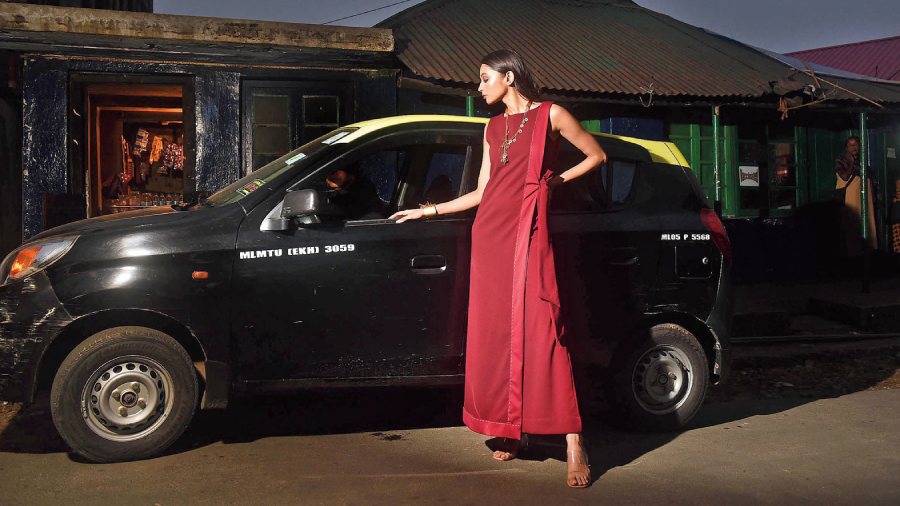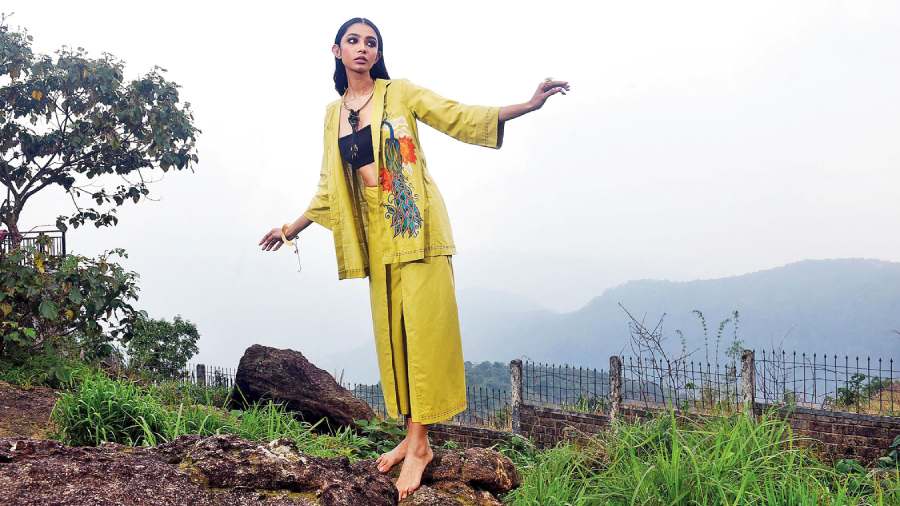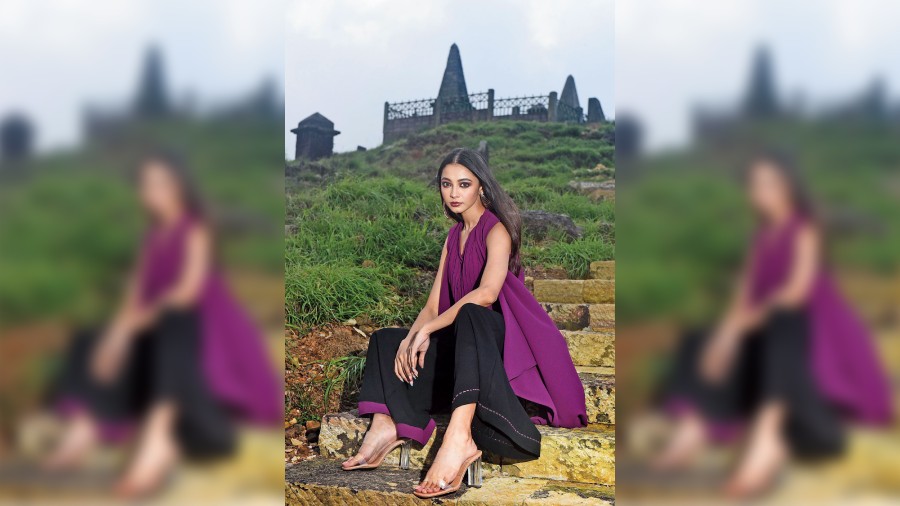Our recent visit to Meghalaya was a unique trip that was not just about travel but also about exploring fashion in the mountain land known as the ‘abode of clouds’. Deciding to explore two fashion lookbooks in the scenic land of hills, lakes, and falls, Shillong’s oldest fashion house, Daniel Syiem Ethnic Fashion House, was one of our obvious choices. Established in 2011, by native boy Daniel Syiem and his business partner Janessaline M Pyngrope, North East’s first fashion house turned 10 last year. The label that houses a pret line, a jewellery line called Ornate Earth and its signature Ryndia collection, has made a name for itself globally in these 10 years and changed the fashion scene in its homeland. t2oS caught up with Daniel to map the remarkable journey of the label laced by its focus on sustainability, the celebration of local craftsmanship and its initiative to empower women. Excerpts.
You have done fashion shows all over India and globally. Do you remember your first ever fashion show?
Prior to the establishment of DSEFH (Daniel Syiem Ethnic Fashion House), I participated in various local and regional shows. In 2000, I was awarded the ‘North East Best Designer’. In 2011, DSEFH was established as a label and our debut fashion show was the Lakme Fashion Week S/S 2013, in Mumbai. It was one of the highlights of our journey. Soon after that, we showcased in Toronto, Rome, Geneva, Tokyo, London and New York. We have done so many shows since and the most recent one was in Shillong, celebrating the 10th anniversary of our label.
How did the label Daniel Syiem come into being?
After trying out different occupations, I came back to my love of fashion and my passion to design with my soul. I experimented, learnt, and had ups and downs but decided to keep pursuing it. Hard work has led us to be an established fashion brand from North-East India and now we have an online shop which caters to customers worldwide. When we started out it was more about letting the world know about our beliefs, sensibility in creating and ethical consumerism through our label. However, turning into pioneers is something that we never had in mind. But seeing the love and appreciation made us work harder to achieve our core goals
Sustainability, eco-friendly production is the essential, trending global focus of the fashion industry now. These ideas were a part of your brand right from its inception. In what ways is the brand nature-friendly?
Our roots and culture are deeply entwined in nature and there are various natural, sustainable techniques, fabrics, and materials that work their way into our work. Of course, the highlight is our work with ‘Ryndia’, a heritage, natural fabric. By joining hands with local weavers of Meghalaya, we develop the fabric right from the yarn stage to elevate its properties. By incorporating modern technology with traditional methods of weaving, using different patterns, designs, and vegetable dyes along with our unique design aesthetic, many of the beneficial properties are enhanced. “Come Return to Nature” is our tagline as our label is about preserving natural, handwoven, rich textiles, which have their roots in the ethnicity of our land and culture. Ryndia is produced by the age-old tradition of extracting silk from the cocoons. All the steps in the sericulture value chain — starting from rearing of silkworms to spinning and reeling of silk to yarn production and dying and finally to weaving, are all environment friendly, cultural, and traditionalistic in nature. We then use the fabrics woven by these weaving communities, for our garments. We encourage them to sustain their lifestyles as artisans by creating income-earning opportunities for them. Since weaving customs are entwined with local traditions, we believe the sustainability of the weavers’ traditional profession is directly proportional to conserving their indigenous lifestyle.
To the best of our ability, we use environment-friendly fasteners made with natural materials, like wood and bamboo, we reuse and recycle our fabrics and reduce wastage by creative use of the fabric as for us it’s not just a piece of fabric but an expression of a culture that speaks the language of the earth.
Your design aesthetic is so global yet rooted in your homeland. How did you conceptualise the label when you started it back in 2011?
When DSEFH was established in 2011, we had a very clear objective of ‘Protecting, Reviving, Uplifting’ the traditional fabrics of North-east India, mainly Meghalaya, and promoting their use by innovating them into modern, contemporary designer wear. Our label is also about showcasing designs that take inspiration from the traditional outfits of the people of Meghalaya, which is home to us. We have such a rich and diverse culture of costumes and dresses of different tribes of our homeland filled with colours, patterns, stories, and weaves that it is an inspiration and a purpose to bring it into the mainstream. It was always three-pronged — the innovative design aesthetic, the story of our culture and our aim to generate income for weavers, workers, and artisans and to revive ancient weaves by promoting their usage. Our design aesthetic is classic, minimalistic and a seamless blend of traditional handwoven fabrics with western silhouettes. It was more of a feeling than a concept. The label focuses on traditional art and craft, bringing about silhouettes which are western in cut but ethnic in touch, thereby catering to both the local and the international market. Keeping in view with the latest trends, the label comprises designs that are simple yet elegant by bringing together all the various elements to produce garments which are all about style, comfort and fit.
In what ways did the traditional and cultural fashion aesthetics and style sensibilities of your homeland inspire you in your journey as a designer?
I draw a lot of inspiration from my roots, land and culture. The beautiful landscape, the buildings and architecture around Shillong, the stylish people of the city and our traditional outfits, music, and fabrics are all imbibed into different aspects of my work. Few of the collections we’ve showcased drew inspiration from some of our folk tales. Few collections use traditional music and dance. One of our iconic pieces is the Jainsem dress. The Jainsem is the traditional attire of our local women here. The Jainsem dress is my take on it, making it more wearable for women all over.
Your label has been launched in four cities abroad — New York, Toronto, London, Canada. Could you tell us about your journey of taking the label global from the hills of North East and its reception there?
The journey of taking our label global was challenging but our team is a strong bunch. Throughout, we relentlessly and tirelessly kept reminding ourselves that “this is happening, no matter what!” The first time we showcased abroad (New York 2014) was one of the most special memories that we hold dear. Everyone loved the collection we presented, and the adoration and admiration was heart-warming. It gave a sense of satisfaction and encouraged us to keep telling the story of our land, people, and culture through our clothes. Our modified Jainsem ensemble is now an iconic piece being worn by clients all over the world and that gives us a sense of accomplishment while inspiring us to continue the journey.
What kind of challenges did you have to face?
The biggest challenge was rooting for funds. It was no small expenditure to be travelling abroad for a fashion show. Government intervention and financial assistance from private entities were not coming through since people were sceptical about the outcome and whether the effort was worth it. DSEFH worked against all odds and we sailed through and came out with roaring applause and appreciation for the works we were doing with the weaving community and the value we gave to the ‘Ryndia’ Fabric.
Through the establishment of your label, you revived the fabric Ryndia. What importance does this fabric locally hold and how have you explored it over the years through your label?
We have a soul connection with ‘Ryndia’ and treat it with immense reverence as we appreciate the hands that have woven this rich fabric. It is a matter of happiness for my entire team that the fabric we chose to throw the spotlight on, is now being used by upcoming designers from our state and our state government also is promoting this fabric and creating outlets to make it available to more and more people.
I was encouraged to work with this fabric by my late friend, Bah Tennyson, and around that time I met my now business partner Janessaline. Her work took her to different villages and in one of these visits, she came across the weavers of Ri-Bhoi district in Meghalaya who make the Ryndia fabric. We both became aware that this precious fabric was dying a slow death. We became focused on ways to revive it and reignite passion in the weavers for this heritage craft as many were giving up weaving as their main occupation as it was not resulting in any income for them. Armed with different backgrounds, both of us entered this partnership with one shared vision — to promote the Ryndia fabric in an ethical manner.
How has your label helped the development of the weaving community of this fabric through its revival?
I do feel we have succeeded in reigniting passion, pride, and remuneration at the grassroots level in our weaving community. Our endeavours have included involving them in our international and national shows and exhibitions apart from using their fabrics for our various collections. The weaving hubs have expanded to different villages, and more and more people, including newcomers, have become interested in the weaving process.
Your label turned 10 last year and expanded digitally. Has the clientele also expanded?
Absolutely. We were fortunate enough to have the support of family and friends, our esteemed clients as well as support from the Government of Meghalaya. We are grateful that we have been able to set up an online shop that caters to clients worldwide. Yes, our clientele has expanded. We could say that the challenges are the limited supply of the fabric and that the exact same colours might not be available again, but this is also the exclusivity and USP of the fabric.
Being a trailblazer in the fashion industry from the North-east, how has your label influenced or impacted the growth of this industry in your homeland?
I feel that newcomers have been interested in working with local fabrics. It has definitely generated a lot of interest in our fabrics, design sensibilities and homeland but to be honest, there is a lot more to achieve in this department. We collectively need to work harder to be at par with the rest of the fashion fraternity around the world.
From using sustainable means of production to emphasizing minimalism and focusing on women empowerment through employment, your label has been futuristic in a way for the past 10 years. What are your plans with the label and what is the focus of the label at present?
Yes, that is true! We have a woman at the helm running the fashion house — my business partner Janessaline Mary Pyngrope, my core team has women in it and our weavers are all women. At present, we are focussing on improving sales through the online shop and bringing out regular collections for our clients. The label also hopes to provide a window to both domestic and international buyers with an opportunity to peep into our culture and tradition.

Daniel and Janessaline (second from the left,sitting) with their weavers

My association with DSEFH has been a life-changing journey, especially because I had no inclination towards the fashion fraternity. But when I got in touch with Daniel, I saw he was true to his work, humble, passionate and uplifting the artisans, craftsmen to sustain through the medium of fashion and that is what got me thinking to venture into the fashion world. The fact that he honours women keeps us motivated and chooses ethical means of production. I feel blessed to say we are one of the pioneers in promoting slow fashion, sustainable fashion. We kept the weavers along with us all the way in our 10-year journey. We are still a niche market and still growing. Creating mass production is not possible for us based on the availability of the authentic fabric. For us it is not just about the business but there is a social cause too.
Janessaline, co-founder and business head, DSEFH
Model Diti Saha sported outfits from Daniel Syiem’s label for an exclusive The Telegraph lookbook shot at four stops while driving down the hills in Cherrapunji, capturing the architecture, landscape, history and tranquility of the place

Diti channelled an elegant look in the maroon Jainsem dress, inspired from the traditional attire of the Khasi women of Meghalaya. The original one made with two equal pieces of cloth and worn with a blouse and skirt, is interpreted here as a statement one-piece outfit with burgundy panelling. Khliehshnong sohra (the main market) was chosen as the backdrop for this shot.

The classy black and off-white gown made of DSEFH’s signature fabric Ryndia (eri silk) is designed with a high slit, intricate baroque motifs around the chest and waist, and piping along the shoulder and hemline. The shot was captured in Nongsawlia, with a house in the background built in the 1840s, following the typical architectural pattern of the area. Thomas Jones, the first missionary of the Presbyterian Church of Wales, first came to the Khasi hills in Cherrapunji around that time and was given this land to build the church, school and bungalows in this place.

The vividly hand-painted peacock-motif shirt with a band collar, buttoned-down front with three-quarter sleeves, is elegant and versatile, paired with a bustier and palazzo pants for a semi-formal, casual look. The scenic Polo Orchid resort in Meghalaya with the view of the mountain landscape was chosen to shoot this look.

The purple draped top is from Daniel’s signature collection designed with thigh-length flowy drapes, paired with black palazzos with purple panelling. The steps of the Nongsawlia Presbyterian cemetery, opposite the Nongsawlia Presbyterian church (established in 1846), was our chosen spot for this shot featuring an easy-breezy chic look.
Pictures: Pabitra Das
Styling, Hair and Make-up: Abhijit Paul
Jewellery sourced by: Sumit Sinha from Zaza by Somya
